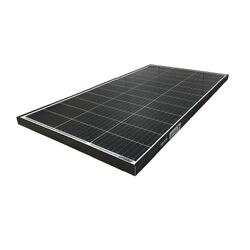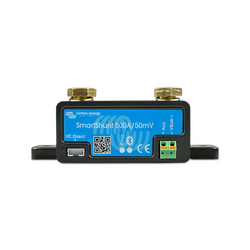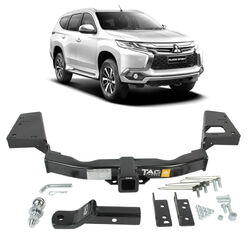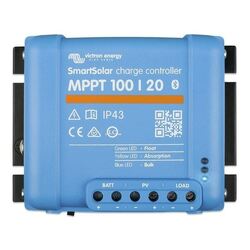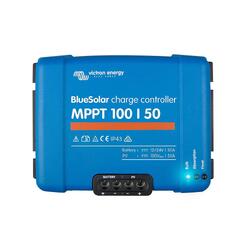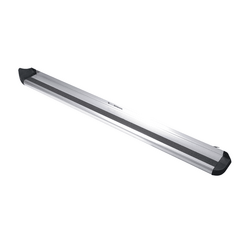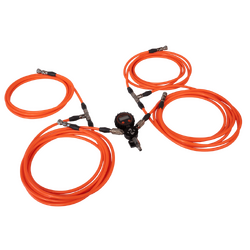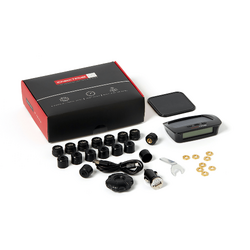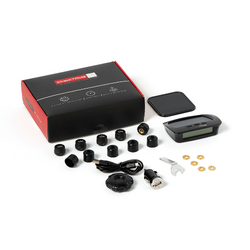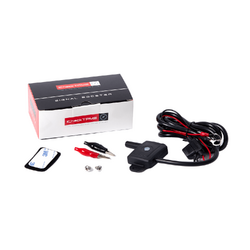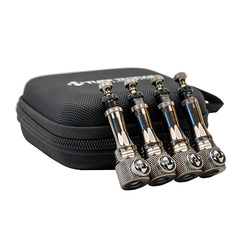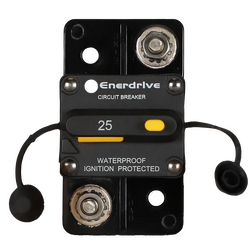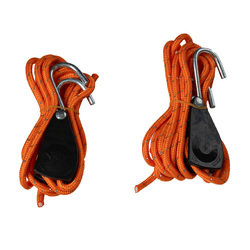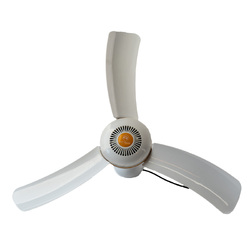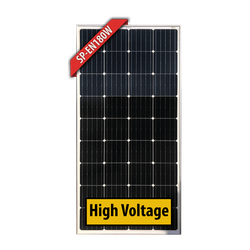Victron Bluesolar MPPT:
A solar charger gathers energy from your solar panels, and stores it in your batteries. Using the latest, fastest technology, BlueSolar maximises this energy-harvest, driving it intelligently to achieve full charge in the shortest possible time. BlueSolar maintains battery health, extending its life.
PWM and MPPT charge controllers are both widely used to charge batteries with solar power. The PWM controller is in essence a switch that connects a solar array to the battery. The result is that the voltage of the array will be pulled down to near that of the battery. The MPPT controller is more sophisticated (and more expensive): it will adjust its input voltage to harvest the maximum power from the solar array and then transform this power to supply the varying voltage requirement of the battery plus load. Thus, it essentially decouples the array and battery voltages so that there can be, for example, a 12 volt battery on one side of the MPPT charge controller and panels wired in series to produce 36 volts on the other.
It is generally accepted that MPPT will outperform PWM in a cold to temperate climate, while both controllers will show approximately the same performance in a subtropical to tropical climate. Besides performing the function of a basic controller, an MPPT controller also includes a DC to DC voltage converter, converting the voltage of the array to that required by the batteries, with very little loss of power.
An MPPT controller attempts to harvest power from the array near its Maximum Power Point, whilst supplying the varying voltage requirements of the battery plus load. Thus, it essentially decouples the array and battery voltages, so that there can be a 12 volt battery on one side of the MPPT charge controller and two 12 Vpanels wired in series to produce 36 volts on the other. If connected to a PV array with a substantially higher nominal voltage than the battery voltage, an MPPT controller will therefore provide charge current even at very high cell temperatures or in low irradiance conditions when a PWM controller would not help much.
As array size increases, both cabling cross sectional area and cable length will increase. The option to wire more panels in series and thereby decrease current, is a compelling reason to install an MPPT controller as soon as the array power exceeds a few hundred Watts (12 V battery), or several 100 Watts (24 V or 48 V battery)
Features:
Ultrafast Maximum Power Point Tracking (MPPT)- Especially in case of a clouded sky, when light intensity is changing continuously, an ultra-fast MPPT controller will improve energy harvest by up to 30% compared to PWM charge controllers and by up to 10% compared to slower MPPT controllers.
Advanced Maximum Power Point Detection in case of partial shading conditions- If partial shading occurs, two or more maximum power points may be present on the power-voltage curve. Conventional MPPTs tend to lock to a local MPP, which may not be the optimum MPP. The innovative BlueSolar algorithm will always maximize energy harvest by locking to the optimum MPP.
Outstanding conversion efficiency- No cooling fan. Maximum efficiency exceeds 98%. The full output current up to 40°C (104°F).
Flexible charge algorithm- Fully programmable charge algorithm (see the software page on our website), and eight pre-programmed algorithms, selectable with a rotary switch (see manual for details).
Extensive electronic protection- Over-temperature protection and power derating when temperature is high. PV short circuit and PV reverse polarity protection. PV reverse current protection.
Internal temperature sensor- Compensates absorption and float charge voltage for temperature.
Real-time data display options- ColorControl GX or other GX devices: see the Venus documents on our website. A smartphone or other Bluetooth-enabled device: VE.Direct Bluetooth Smart dongle needed.
BlueSolar Charge Controller | MPPT 100/30 | MPPT 100/50 | |
Battery voltage | 12/24V Auto Select | ||
Rated charge current | 30A | 50A | |
Nominal PV power, 12V 1a,b) | 440W | 700W | |
Nominal PV power, 24V 1a,b) | 880W | 1400W | |
Maximum PV open circuit voltage | 100V | 100V | |
Max. PV short circuit current 2) | 35A | 60A | |
Maximum efficiency | 98% | 98% | |
Self-consumption | 12V: 30 mA 24V: 20 mA | ||
Charge voltage 'absorption' | Default setting: 14,4V / 28,8V (adjustable) | ||
Charge voltage 'float' | Default setting: 13,8V / 27,6V (adjustable) | ||
Charge algorithm | multi-stage adaptive | ||
Temperature compensation | -16 mV / °C resp. -32 mV / °C | ||
Protection | Battery reverse polarity (fuse, not useraccessible) PV reverse polarity, Output short circuit, Overtemperature | ||
Operating temperature | -30 to +60°C (full rated output up to 40°C) | ||
Humidity | 95%, non-condensing | ||
Data communication port | VE.Direct See the data communication white paper on our website | ||
ENCLOSURE | |||
Colour | Blue (RAL 5012) | ||
Power terminals | 13 mm² / AWG6 | ||
Protection category | IP43 (electronic components), IP22 (connection area) | ||
Weight | 1,3 kg | 1,3 kg | |
Dimensions (h x w x d) | 130 x 186 x 70 mm | 130 x 186 x 70 mm | |
STANDARDS | |||
Safety | EN/IEC 62109-1, UL 1741, CSA C22.2 | ||
1a) If more PV power is connected, the controller will limit input power. 1b) PV voltage must exceed Vbat + 5V for the controller to start. Thereafter minimum PV voltage is Vbat + 1V. 2) A PV array with a higher sort circuit current may damage the controller. | |||
| SKU | SCC020030200 |
|---|---|
| Barcode # | 8719076025542 |
| Brand | Victron |
| Shipping Weight | 2.0000kg |
Victron Bluesolar MPPT:
A solar charger gathers energy from your solar panels, and stores it in your batteries. Using the latest, fastest technology, BlueSolar maximises this energy-harvest, driving it intelligently to achieve full charge in the shortest possible time. BlueSolar maintains battery health, extending its life.
PWM and MPPT charge controllers are both widely used to charge batteries with solar power. The PWM controller is in essence a switch that connects a solar array to the battery. The result is that the voltage of the array will be pulled down to near that of the battery. The MPPT controller is more sophisticated (and more expensive): it will adjust its input voltage to harvest the maximum power from the solar array and then transform this power to supply the varying voltage requirement of the battery plus load. Thus, it essentially decouples the array and battery voltages so that there can be, for example, a 12 volt battery on one side of the MPPT charge controller and panels wired in series to produce 36 volts on the other.
It is generally accepted that MPPT will outperform PWM in a cold to temperate climate, while both controllers will show approximately the same performance in a subtropical to tropical climate. Besides performing the function of a basic controller, an MPPT controller also includes a DC to DC voltage converter, converting the voltage of the array to that required by the batteries, with very little loss of power.
An MPPT controller attempts to harvest power from the array near its Maximum Power Point, whilst supplying the varying voltage requirements of the battery plus load. Thus, it essentially decouples the array and battery voltages, so that there can be a 12 volt battery on one side of the MPPT charge controller and two 12 Vpanels wired in series to produce 36 volts on the other. If connected to a PV array with a substantially higher nominal voltage than the battery voltage, an MPPT controller will therefore provide charge current even at very high cell temperatures or in low irradiance conditions when a PWM controller would not help much.
As array size increases, both cabling cross sectional area and cable length will increase. The option to wire more panels in series and thereby decrease current, is a compelling reason to install an MPPT controller as soon as the array power exceeds a few hundred Watts (12 V battery), or several 100 Watts (24 V or 48 V battery)
Features:
Ultrafast Maximum Power Point Tracking (MPPT)- Especially in case of a clouded sky, when light intensity is changing continuously, an ultra-fast MPPT controller will improve energy harvest by up to 30% compared to PWM charge controllers and by up to 10% compared to slower MPPT controllers.
Advanced Maximum Power Point Detection in case of partial shading conditions- If partial shading occurs, two or more maximum power points may be present on the power-voltage curve. Conventional MPPTs tend to lock to a local MPP, which may not be the optimum MPP. The innovative BlueSolar algorithm will always maximize energy harvest by locking to the optimum MPP.
Outstanding conversion efficiency- No cooling fan. Maximum efficiency exceeds 98%. The full output current up to 40°C (104°F).
Flexible charge algorithm- Fully programmable charge algorithm (see the software page on our website), and eight pre-programmed algorithms, selectable with a rotary switch (see manual for details).
Extensive electronic protection- Over-temperature protection and power derating when temperature is high. PV short circuit and PV reverse polarity protection. PV reverse current protection.
Internal temperature sensor- Compensates absorption and float charge voltage for temperature.
Real-time data display options- ColorControl GX or other GX devices: see the Venus documents on our website. A smartphone or other Bluetooth-enabled device: VE.Direct Bluetooth Smart dongle needed.
BlueSolar Charge Controller | MPPT 100/30 | MPPT 100/50 | |
Battery voltage | 12/24V Auto Select | ||
Rated charge current | 30A | 50A | |
Nominal PV power, 12V 1a,b) | 440W | 700W | |
Nominal PV power, 24V 1a,b) | 880W | 1400W | |
Maximum PV open circuit voltage | 100V | 100V | |
Max. PV short circuit current 2) | 35A | 60A | |
Maximum efficiency | 98% | 98% | |
Self-consumption | 12V: 30 mA 24V: 20 mA | ||
Charge voltage 'absorption' | Default setting: 14,4V / 28,8V (adjustable) | ||
Charge voltage 'float' | Default setting: 13,8V / 27,6V (adjustable) | ||
Charge algorithm | multi-stage adaptive | ||
Temperature compensation | -16 mV / °C resp. -32 mV / °C | ||
Protection | Battery reverse polarity (fuse, not useraccessible) PV reverse polarity, Output short circuit, Overtemperature | ||
Operating temperature | -30 to +60°C (full rated output up to 40°C) | ||
Humidity | 95%, non-condensing | ||
Data communication port | VE.Direct See the data communication white paper on our website | ||
ENCLOSURE | |||
Colour | Blue (RAL 5012) | ||
Power terminals | 13 mm² / AWG6 | ||
Protection category | IP43 (electronic components), IP22 (connection area) | ||
Weight | 1,3 kg | 1,3 kg | |
Dimensions (h x w x d) | 130 x 186 x 70 mm | 130 x 186 x 70 mm | |
STANDARDS | |||
Safety | EN/IEC 62109-1, UL 1741, CSA C22.2 | ||
1a) If more PV power is connected, the controller will limit input power. 1b) PV voltage must exceed Vbat + 5V for the controller to start. Thereafter minimum PV voltage is Vbat + 1V. 2) A PV array with a higher sort circuit current may damage the controller. | |||
| SKU | SCC020030200 |
|---|---|
| Barcode # | 8719076025542 |
| Brand | Victron |
| Shipping Weight | 2.0000kg |





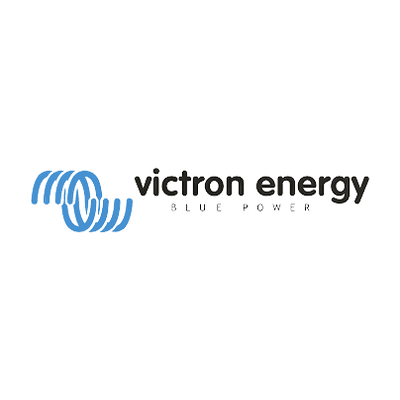




 More info
More info
